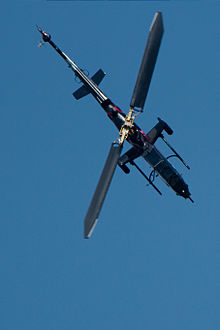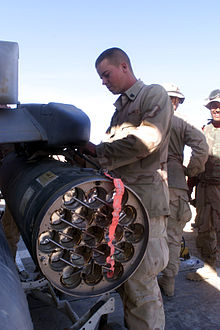Bell AH-1
| Bell AH-1 Cobra | |
|---|---|
 AH-1W "SuperCobra" from the USMC |
|
| Type: | Light attack helicopter |
| Design country: | |
| Manufacturer: | |
| First flight: |
September 7, 1965 |
| Commissioning: |
1967 |
| Production time: |
In series production since 1967 |
| Number of pieces: |
1,134 |
The Bell AH-1 Cobra is the first real attack helicopter ( English attack helicopter , AH ) of the US manufacturer Bell Helicopter . When it was delivered in the mid-1960s, it was the world's first pure attack helicopter; previously there were only armed transport helicopters .
Designations
Some Bell UH-1 B "Huey" were heavily armed for escort duties and therefore also called "Cobra". The engineers at Bell found out about this and adopted the name - although contrary to Army rules it was not derived from an Indian tribe. Since the Army was supposed to get a new version of the UH-1 instead of a new type, it was originally called the UH-1H "HueyCobra" and was only renamed AH-1G after the start of series production.
history
The need for armed escort helicopters became apparent for the first time in the Vietnam War . Helicopters were used on a large scale to carry troops and equipment, but could not provide self-protection as they were too heavy and slow with rocket launchers and door-mounted machine guns . Accompanying United States Air Force fighter jets could only be a stopgap measure, as the jet fighters could never really stay close to the helicopters because of their higher speeds.
Bell Helicopter had been experimenting with attack helicopters based on the Bell 47 as early as the 1950s . In mid-1962, Bell presented the US Army with a mock-up of the D-255 draft, which was used in 1964 in the form of the modified D-262 for the Advanced Aerial Fire Support System (AAFSS) . Bell lost this competition and nevertheless developed the model 206 from December 1964, which took off for the first flight on September 7, 1965 and proved to be a stroke of luck in the wake of the Vietnam War and the unavailable Lockheed AH-56 A from the AAFSS program. The first two pre-series machines of the machine now known as the Bell AH-1G were ordered by the US Army on April 7, 1966. The name already suggests that Bell used components of its current transport helicopter model, the Bell 204 UH-1C "Iroquois" , as far as possible , such as the rotor, gearbox and turbines, in order to keep costs down.
The extremely slim fuselage was new, and thanks to the reduction to the minimum, it could be designed. This became trend-setting for all of the following attack helicopter types, which therefore only offer the enemy a very small frontal impact area when attacking. The gunner occupies the front seat in the Cobra, the pilot sits slightly higher at the rear. The gunner primarily operates the gun and the external weapons. If necessary, the crew members can also take on the other's tasks, for which both cockpits are equipped with the basic flight instruments, control sticks and pitch levers .
In contrast to the prototype, the AH-1G had a fixed skid landing gear and the tail rotor was moved to the right in the course of production. The lower tail fin of the tail unit has also been omitted. The canopy, which was glazed all around and rounded at the top, with a panoramic view made of unarmoured safety glass, created an unpleasant greenhouse effect. That is why the first AH-1G delivered were equipped with ventilation nozzles. In the tropical areas of Southeast Asia, however, these were insufficient. For this reason, the workshops in Vietnam equipped the helicopters with air conditioning systems called the “environmental control unit” (ECU); later these systems were installed during series production. The “greenhouse glazing” represented the highest infrared signature of the helicopter, even the hot engine exhaust gases were less attractive to infrared-guided weapons. In addition, the tail rotor of the late AH-1G was relocated from the left to the right side for reasons of stability compared to the UH-1C, otherwise almost the entire tail area was taken over by the UH-1C "Huey". In the early version, two landing lights were housed in the plexiglass nose, in the late version a landing light could be folded out below the nose.
The retractable reflex sight M73 served as aiming aid for all weapons . For the chin tower, the computer system compensates for the helicopter's own movements, wind influences and target movements.
The AH-1G was only lightly armored. The armored shield in front of the cockpit protected against fire with weapons up to caliber 7.62 mm ; The hydraulic and fuel supply systems were also protected from fire and fragmentation.
As there was a great need for attack helicopters in Vietnam for the reasons mentioned above and the gradual expansion of the war and the competing program Lockheed AH-56 "Cheyenne" was canceled due to uncontrollable conceptual deficiencies, the Cobra, initially only intended as a temporary solution, quickly convinced and proved itself soon to be indispensable.
As early as August 1967, the first HueyCobras reached the US troops in support of the South Vietnamese army. In the Vietnam War , the United States Army had to write off 157 HueyCobras through anti-aircraft cannons (FlaK), four through anti-aircraft missiles (FlaRak) and twelve through attacks on airfields as total loss through enemy action and 109 through accidents. The USMC lost ten Cobras in the same period. However, most were only slightly damaged, then repaired and put back into service. The main task of the HueyCobras at that time was the use as air-powered artillery, armed escort and armed reconnaissance. It soon turned out that the M64 turret did not provide enough firepower even when used in conjunction with two M18 containers. The problem with the powerful unguided FFAR rockets was that the highly professional Army instructors were able to fire them precisely during demonstrations, but the inexperienced Army pilots could not achieve this precision. At night, targets could still be fought in conjunction with UH-1 “Hueys”, which were equipped with bundles of headlights on the sides. As a rule, however, the HueyCobras stayed on the ground in bad weather and at night.
After the North Vietnamese shot down AH-1Gs with 9K32 “Strela-2” anti-aircraft guided weapons in the spring offensive in 1972 , measures had to be taken to improve the infrared signature. A "sugar scoop" (or "sugar bowl") called an engine exhaust gas diverter was attached to the engine outlet. With its toilet bowl-like shape and a heat-insulating cladding made of asbestos and metal layers, it diverted the hot exhaust gases into the main rotor, where they were mixed with ambient air and dispersed. The slightly tinted cockpit windows were replaced by clear ones in later versions.

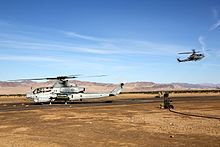
The further development of the G variant was the AH-1Q "HueyCobra" .
With the delivery of the new Hughes AH-64A "Apache" , the United States Army replaced a large part of its AH-1F "Cobra" in the late 1980s. Only one Air Cavalry - Battalion of the Army uses still AH-1F Cobras; the rest are in reserve with the National Guard . From the end of 2004 there will only be TAH-1S "Surrogates" in the Army for night flight training for Apache pilots. However, the United States Marine Corps continues to use the "SuperCobra" variant to this day, as it is ideally tailored to the needs of this special force and the cramped conditions on their amphibious ships (small, light, small space requirement, seaworthy and in proportion large firepower). Since the Marine Corps did not want to do without the agile Cobras, their AH-1J / T stocks were modernized to the level of the improved model AH-1W "SuperCobra" from existing cells. The AH-1W "SuperCobra" is more agile than its predecessor AH-1T thanks to its two more powerful T700 turbines and can finally carry the full armament over longer distances into the combat area. It also has newer avionics and the ability to air-to-air missiles of the type AIM-9 Sidewinder carry. As a result, the "SuperCobra" poses a threat to enemy helicopters and fighter planes. The USMC mostly leaves out the AIM-9 Sidewinder, since it otherwise occupies the two most important suspension points. The existing armor only includes the two pilot seats and the rotor blades, which can withstand anti-aircraft ammunition up to a caliber of 23 mm. The remainder of the helicopter is unarmored, which greatly reduces its survivability under enemy fire. During Operation Urgent Fury , for example, two AH-1Ts crashed after being shot at at the beginning of the attack. The wire-guided TOW missiles were supplemented by the modern laser-guided AGM-114 “Hellfire” . Since the expensive Hellfire can only be used sensibly against armored targets, the cheaper TOW missiles are more efficient when deployed in Afghanistan and Iraq .
The AH-1 model, which was remarkably successful despite a very short development time, was by no means exhausted: The latest model AH-1Z "Viper" now has the latest computer and targeting technology and a four-bladed bearingless main rotor, with which flight performance could be further improved . The AH-1Z, however, no longer has the ability to use the anti-tank guided weapons of the TOW type. During the further development of the AH-1Z, Bell modernized the UH-1N to the UH-1Y "Venom" at the same time as part of the H-1 program . As a result, a large part of the components such as engine, gearbox, avionics, rotor head etc. should be able to be used for both helicopters. Bell assumes that the 84% interchangeable parts will reduce operating costs by approximately 3 billion US dollars over a 30-year useful life.
Cobra versions for US Army and Marines
(The version "numbering" has been anything but stringent over the years and is therefore arranged chronologically below)
-
AH-1G "HueyCobra" - First production version for the US Army, built between 1966 and 1973 at Bell in Fort Worth , divided into early (tail rotor left) and late versions (tail rotor right)
- 1966: 110 × AH-1G early (block 1) serial numbers 66-15248 to 66-15357
- 1967: 420 × AH-1G early (block 2) serial numbers 67-15450 to 67-15869
- 1968: 308 × AH-1G early (block 3) serial numbers 68-15000 to 68-17113
- 1969: 38 × AH-1G early (block 4) serial numbers 69-16410 to 69-16447
- 1970: 174 × AH-1G late (block 5) serial numbers 70-15936 to 70-16105
- 1971: 70 × AH-1G late (block 6) serial numbers 71-15090 to 71-21052
- 1972: 4 × AH-1G late (block 7) serial numbers 72-21461 to 72-21464
- AH-1Q "HueyCobra" - armed with TOW , TSU aiming system (Telescopic Sight Unit, an aiming system for the TOW), but severely underpowered
- AH-1S "HueyCobra" - modernization program for "old buildings" -AH-1G of the Army, new launch system for TOW missiles, 1980
- AH-1P "Cobra" - improved AH-1S with straight canopy glazing and fully composite Kaman K747 rotor blades; these include tapered rotor ends, also known as AH-1S Step 1 known
- AH-1E "Cobra" - improved AH-1P with generator, also known as AH-1S Step 2
- AH-1F "Cobra" - equipped with new optical target acquisition, radar warning device as well as all previous upgrades, current "standard Cobra" of the US Army
- AH-1J "SeaCobra" - first navalized version for the Marine Corps with two turbines and rotor brake
- AH-1T "SeaCobra" - enhanced USMC version with BGM-71 TOW and TSU, extended fuselage
- AH-1W "SuperCobra" - upgrade of old AH-1T; enhanced performance with two new turbines, new avionics and armament
- AH-1Z "Viper" - 58 new buildings are planned as well as the upgrading of 131 old AH-1W "SuperCobra" with four-bladed, jointless and bearingless rotor, new target acquisition system AAQ-30 Hawkeye with FLIR , laser target illuminator and improved night vision system, helmet visor, millimeter wave Radar and AGM-114 Hellfire, modified stub wings, cooled engine outputs and many systems analogous to the Bell UH-1Y "Venom" (engine, APU, tail boom, four-bladed tail rotor and parts of the electronics). The machine was declared operational by the US Marine Corps in February 2011.
- GAH-1S - This is an unfit to fly AH-1S that was used to train crew and mechanics on the ground. Only a single helicopter was delivered.
- TAH-1S "Surrogate" - This trainer variant has a deflated tower and a PNVS sensor on the nose. He is also known as the "Night Stalker". The cabin windows for IFR flights can also be darkened for the pilot seated in the back. This Northrop modified AH-1S has the same PNVS sensor as the AH-64A Apache. The chin tower was exchanged for a pilot night vision sensor (PNVS) of the AH-64 Apache. The machines are used to train the AH-64 pilots, with night flight and night landing training being the main focus. A total of 15 AH-1S “Cobra” helicopters were converted at Northrop in the 1980s.
- TAH-1F "Cobra" - This trainer variant is equipped with double control like the TAH-1S and is used for retraining on the AH-1F. Between 1979 and 1982 a total of 41 AH-1G "HueyCobra" were converted to the TAH-1F stand.
- TH-1G "HueyCobra" - trainer variant with double control for retraining on the AH-1G. At least one helicopter was built.
Technical specifications of the model AH-1W
| Parameter | Data |
|---|---|
| Length over all | 17.68 m |
| Hull length | 13.97 m |
| Height above everything | 4.31 m |
| Main rotor area | 168.10 m² |
| Width with stub wings | 3.28 m |
| Main rotor diameter | 14.63 m |
| Tail rotor diameter | 2.97 m |
| Engine | General Electric T700-GE-401 twin-shaft power unit with 1,196 kW (1,626 hp) each, connected by a gearbox |
| Top speed | 315 km / h |
| Service ceiling | 6,000 m |
| Hover altitude | 915 m / 4,750 m (without / with ground effect) |
| Range | approx. 635 km |
| Empty weight | 4,656 kg |
| Max. Takeoff weight | 6,690 kg |
| Fuel tank volume | 1,153 l internal
1,165 l externally in four 77-gal additional tanks |
Engine, rotors and power supply AH-1G
- Turbine: T-53-L-13
- Rotor: two wide, semi-rigid all-metal rotor blades type B540 without the well-known stabilizing bar of the Huey. The rotor blades are wider than those of the Huey.
- Tail rotor: two-bladed rigid full metal rotor
- Power supply: battery-operated direct current network with 28 volts
- Fuel tank: 936 liters of JP-4 fuel, self-sealing and armored to fire with 12.7 mm caliber
Armament
Fixed armament in the moveable children's turret
- AH-1G / Q
- 1 × Emerson Electric (X) M-64 / TAT-102A rotating turret with a 7.62 mm Gatling machine gun General Electric M134 "Minigun" (GAU-2B / A) with an ammunition container for 8000 rounds of ammunition (only AH -1G block 1 and 2).
- 1 × Emerson Electric (X) M28 / TAT-141 rotating turret with 2 × swiveling weapons (e.g. 2 × automatic 40 mm M75 grenade launchers, later M129 grenade launchers or two M134 minigun Gatling machine guns or a combination of both can be installed A combination of grenade launcher and machine gun has proven itself, since otherwise a problem with the ammunition supply could occur with two identical systems. The ammunition is housed in a drum behind the turret directly under the gunner. This allows 4000 rounds of 7.62 mm -Munition or 300 rounds of 40 mm ammunition can be carried. The XM28 turret can be rotated horizontally over a 230 ° circular arc. The maximum deflection is 25 ° upwards and 60 ° downwards. The control is hydraulic, resulting from the control inputs The gunner with the Aircraft Turret Sighting Station (a kind of control horn / joypad for the tower) swivels the tower with it. This tower variant was only used by the AH-1G of blocks 3 and 4.
- 1 × (X) M28A1 tower (only AH-1G blocks 5 and 6)
- AH-1E / F / S
- 1 × GTK4A children's turret (UTS "universal turnet") with a three-barreled 20 mm Gatling automatic cannon General Dynamics Armament Systems M197 with 700 rounds in the ammunition container. The turret was designed in such a way that the M197 automatic cannon could have been exchanged for a Bushnell M230 automatic cannon in 30 mm caliber in 30 minutes, but the US Army did not adapt this option. Before weapons could be fired from the external load carriers, the turret had to be pivoted forward and locked.
- AH-1J / T / W / Z
- 1 × A / A49E-7 children's turret with a three-barreled 20 mm Gatling automatic cannon General Dynamics Armament Systems M197 with 750 rounds in the ammunition container.
- Ordnance for a maximum of 2,600 kg at four suspension stations under the two stub wings
- Air-to-air guided missile
- 2 × LAU-7 starter rails each for 1 × Raytheon AIM-9L / M-8 / X "Sidewinder" (one launcher each at the outer suspension points)
- Air-to-surface guided missile
- 2–4 × M299 launchers, each with 4 × Boeing Corp / Martin Marietta AGM-114K / L / N / M1 "Hellfire" - laser remote-controlled anti-tank guided missile
- 2–4 × launcher racks each with 2 × Raytheon BGM-71B / C / D / H "TOW" - wire-remote controlled (SACLOS) anti-tank guided missiles (up to AH-1W)
- 2 × launcher racks each with 2 × Rafael Spike-ER - wire-remote-controlled (SACLOS) anti-tank guided missiles
- 2 × LAU-7 launch rails each for a Motorola AGM-122A "Sidearm" anti-radar guided missile
- Unguided air-to-surface missiles
- 4 × rocket tube launch containers LAU-61/19/261 or XM-159/200 for 19 × unguided Hydra air-to-surface missiles each ; Caliber 70 mm / 2.75 inch
- 4 × rocket tube launch containers LAU-260/68 or XM-157/158 for 7 × unguided Hydra air-to-surface rockets each ; Caliber 70 mm / 2.75 inch
- 2 × rocket tube launch container LAU-10B / A for 4 × unguided Zuni air-to-ground missiles each ; Caliber 127 mm / 5 inch
- 4 × rocket tube launch container TBA 68-7 for 7 × unguided air-to-ground missiles SNEB ; Caliber 68 mm
- 4 × TBA 68-12C rocket tube launch containers for 12 × unguided air-to-ground missiles SNEB; Caliber 68 mm
- 2 × rocket tube launch container TBA 68-22C for 22 × unguided air-to-ground missiles SNEB; Caliber 68 mm
- Unguided free-fall bombs
- 2 × CBU-55 / B (235 kg / 500 lb aerosol bomb )
- 2 × Mk.77 Mod 2 / Mod 4 (230 kg / 500 lb napalm incendiary bomb)
- 2 × Mark 81 LDGP (127 kg / 260 lb free fall bomb )
- 2 × Mark 82 LDGP (227 kg / 500 lb free fall bomb)
- 2 × M118 smoke grenade launcher: The launcher developed for the US Army as the XM-118 was designed to drop twelve smoke grenades in free fall. The launcher was mainly mounted on the suspension of the stub wings of the Bell AH-1G "HueyCobra". In addition, the grenade launcher could be lashed to the underside of the XM-157 / B rocket launcher.
- Additional container
- 2 × GPU-2 / A machine cannon containers (three-barreled 20 mm Gatling machine cannon M197 with 300 rounds of ammunition. The rate can be selected between 750 or 1500 rounds / minute.)
- 2 × (X) M18A1 or SUU-11 / A machine gun containers (7.62 mm Gatling six-barreled General Electric M134 machine gun ). The MAU-57 container has space for 1500 rounds of 7.62 mm ammunition, an accumulator for the rotary drive of the minigun and an electronic control unit. The rate can be chosen between 2000 or 4000 rounds / minute.
- 1 × (X) M35 automatic cannon upgrade kit (six-barrel 20 mm Gatling automatic cannon General Electric M195 with 950 rounds of ammunition.)
- 2–4 × additional disposable fuel tanks with 291 liters (77 US gal) kerosene
- 2 × disposable additional fuel tanks with 378 liters (100 US gal) kerosene
- 4 × drop-off additional fuel tanks with 870 liters (230 US gal) kerosene (only AH-1Z)
Self-protection systems
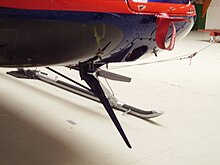
Based on the experience from the deployment in Vietnam , the Army provided their HueyCobras with self-protection systems.
AH-1G
- Passive action
- 1 × exhaust gas cooling diffuser (infrared suppression exhaust air cooler ("sugar scoop" or "sugar bowl")) at the end of the exhaust pipe. This bent tube made of a heat-insulating cladding made of asbestos and metal layers diverts the hot exhaust gases into the main rotor, where the exhaust gases are mixed with the ambient air and dispersed.
- 1 × Garret Air Research exhaust cooling diffuser (longer exhaust opening with lattice tube to reduce the IR signature, only AH-1S Step 3)
AH-1S / F / W / Z
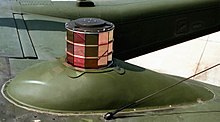
At the AH-1Z, the self-defense systems are coordinated via the AN / ALQ-211 SIRCM
- Active measures
- 2–4 × BAE Systems AN / ALE-47 decoys with 30 × 25.4 mm decoys each (e.g. M206 flare propellants or RR-170A / AL chaff propellants 1 ″ × 1 ″) (only AH-1Z)
- 2 × M130 decoys launchers with 30 decoys each (only AH-1J, S Step 2, P)
- 1 × BAE AN / ALQ-144A (V) 3 infrared interference radiators (IRCM)
- 1 × ITT Avionics AN / ALQ-136 (V1) radar jammer (only AH-1F)
- Passive action
- 4 × Northrop Grumman AN / APR-39B (V) 2 radar warning sensor
- 4 × BAE AN / AAR-47-MWU laser and missile approach warning sensor (only AH-1Z)
- 2 × cable cutters above the cockpit and under the ammunition storage compartment
- 2 × HIRSS exhaust air cooling diffusers (hover infrared suppressor subsystem) at the end of the exhaust pipes
- Special coating of the outer skin to reduce infrared radiation
operator
Military operator

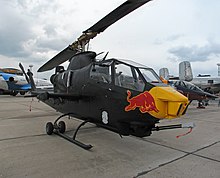
Over the years AH-1 Cobras have been exported to the following countries, the quantities refer to the ordered copies:
-
 Bahrain
Bahrain
- Royal Bahraini Air Force : 42 , 24 AH-1E / P, 6 × TAH-1P, 12 AH-1Z (the latter in 2018)
-
 Iran
Iran
- Iranian Army Aviators : 202 AH-1J
-
 Israel
Israel
- Israeli Air Force : 61 , 6 AH-1G, 30 AH-1S, 12 AH-1E, 13 AH-1F
-
 Japan
Japan
- Japanese Army Aviators : 91 , 2 AH-1E, 89 AH-1S
-
 Jordan
Jordan
- Jordanian Air Force : 33 , 24 AH-1S, 9 AH-1F
-
 Kenya
Kenya
- Kenya Air Force : 3 AH-1E / F (taken over from Jordan)
-
 Pakistan
Pakistan
- Pakistan Army Aviation Corps : 47 , 20 AH-1S, 8 AH-1F, 19 × AH-1Z (the latter still in procurement)
-
 Philippines
Philippines
- Philippine Air Force : 2 AH-1E / F (taken over from Jordan)
-
 South Korea
South Korea
- South Korean Air Force : 62 , 42 AH-1S, 20 × AH-1F
-
 Taiwan
Taiwan
- Taiwan Air Force : 63 AH-1W
-
 Thailand
Thailand
- Thai Air Force : 4 AH-1F
-
 Czech Republic
Czech Republic
- Armed Forces of the Czech Republic : 4 AH-1Z (appointed in 2019)
-
 Turkey
Turkey
- Turkish Land Forces ( Türk Kara Kuvetleri ) : 48 , 32 AH-1P / S, 16 AH-1W
-
 United States
United States
- United States Marine Corps : 299 , 49 AH-1J, 43 AH-1T, 179 AH-1W, 28 AH-1Z
- Former operator
-
 Spain
Spain
- Armada Española : 8 AH-1G
-
 United States
United States
- United States Army : 1116 AH-1G / Q / S / P / E / F
The Spanish Navy and the US Army were the only users who stationed the AH-1 in Western Europe.
Civil operator

-
 United States - Airborne Fire Brigade
United States - Airborne Fire Brigade - US Forest Service : 25 AH-1F (Bell 209 Firewatch Cobra)
- Florida Division of Forestry: 3 AH-1P (Bell 209 "Firesnake")
literature
- Alexander Lüdeke: Bell AH-1 COBRA , Motorbuch Verlag, Stuttgart, 2012, ISBN 978-3-613-03457-0 .
Web links
- FAS AH-1 W
- http://www.waffenhq.de/flugzeuge/ah-1cobra.html
- http://tri.army.mil/LC/CS/csa/aawpns.htm
- http://www.vectorsite.net/avcobra.html
- http://www.heliport.de/
- http://www.fas.org/man/dod-101/sys/ac/ah-1.htm
- http://www.portierramaryaire.com/fichas/ah1_1.php
- http://www.uswarplanes.net/
- http://airwiki.org
Individual evidence
- ↑ FlugRevue January 2009, pp. 51–54, aircraft down to the smallest detail - Bell AH-1 Cobra
- ↑ Alexander Lüdeke: Bell AH-1 COBRA . 1st edition. Motorbuch Verlag, Stuttgart 2012, ISBN 978-3-613-03457-0 , p. 121 .
- ↑ Alexander Lüdeke: Bell AH-1 COBRA . 1st edition. Motorbuch Verlag, Stuttgart 2012, ISBN 978-3-613-03457-0 , p. 118 .
- ↑ Gunslingers in Action. Aircraft No. Fourteen, Squadron Signal Publications, 1974, p. 15.
- ^ Doug Richardson: Modern Fighting Aircraft AH-1. Salamander Books, 1987.
- ↑ https://www.janes.com/article/84637/bahrain-signs-for-ah-1z-attack-helos
- ↑ http://www.janes.com/article/80285/philippines-to-receive-cobra-helos-from-jordan
- ↑ Czech Republic orders H-1 helos, Janes, December 16, 2019





